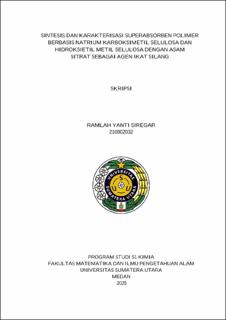| dc.description.abstract | This study investigates the synthesis and characterization of polymer superabsorbents (SAP) based on sodium carboxymethyl cellulose (Na-CMC) and hydroxyethyl methyl cellulose (HEMC). The synthesis of polymer superabsorbents was carried out by mixing Na-CMC and HEMC using a mass ratio of 3:1 in a 2% mass mixture. In the next stage, citric acid was added as a cross-linking agent using varying concentrations of 2%, 3%, 4%, and 5%. The resulting mixture formed a film that was characterized using cross-linking degree testing, water absorption testing, FTIR, DSC, and TGA. The best crosslinking percentage was observed at a citric acid concentration of 3%, yielding 82.10%. The water absorption results showed an optimum value with a 3% citric acid concentration, which could absorb 7.184%, or 359.2 g/g of its dry weight. The FTIR test results showed the formation of SAP, supported by the FTIR spectrum in the mixture of Na-CMC, HEMC, and citric acid as cross-linking agents, with the presence of –OH groups at a wavelength of 3382.1 cm-1 and –COO groups at a wavelength of 1416.4 cm-1, and a new absorption peak at a wavelength of 1687.8 cm-1 indicating the presence of ester groups, which indicates that cross-linking has occurred in the SAP. The results of the thermogram analysis using DSC yielded a glass transition temperature (Tg) value between 109.0 °C, which is between the Tg of Na-CMC and HEMC, namely the Tg of Na-CMC at 148.03 °C and the Tg of HEMC at 113.82 °C. This indicates that there has been polymer network interaction between the three samples. The TGA test was conducted to assess thermal stability, and the results showed that SAP Optimum 3% has better thermal stability compared to Na-CMC | en_US |


